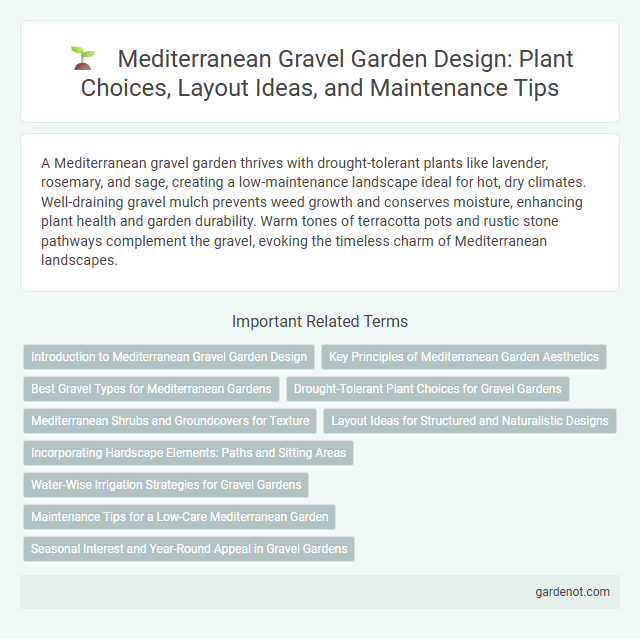A Mediterranean gravel garden thrives with drought-tolerant plants like lavender, rosemary, and sage, creating a low-maintenance landscape ideal for hot, dry climates. Well-draining gravel mulch prevents weed growth and conserves moisture, enhancing plant health and garden durability. Warm tones of terracotta pots and rustic stone pathways complement the gravel, evoking the timeless charm of Mediterranean landscapes.
Introduction to Mediterranean Gravel Garden Design
Mediterranean gravel garden design emphasizes drought-tolerant plants, such as lavender, rosemary, and olive trees, thriving in well-drained, rocky soil with minimal water. Incorporating gravel in shades of terracotta and beige enhances soil moisture retention while reflecting the natural landscape of Mediterranean climates. This sustainable landscaping approach balances aesthetic appeal with water conservation, creating a resilient garden suited for arid environments.
Key Principles of Mediterranean Garden Aesthetics
Mediterranean gravel gardens emphasize drought-tolerant plants such as lavender, rosemary, and olive trees, thriving in well-drained, gravelly soil that mimics natural Mediterranean landscapes. Key principles include creating harmony through the use of muted earth tones, sculptural forms, and textured gravel surfaces that enhance both aesthetics and water conservation. Strategic placement of terracotta pots and stone benches complements the minimalist design while promoting a tranquil, sun-drenched atmosphere.
Best Gravel Types for Mediterranean Gardens
Optimal gravel types for Mediterranean gardens include crushed limestone, decomposed granite, and pea gravel, which offer excellent drainage and complement the region's drought-resistant plants. Crushed limestone provides a light, reflective surface that enhances soil warmth and moisture retention, essential for Mediterranean climates. Pea gravel and decomposed granite promote natural air circulation, preventing soil compaction and supporting healthy root systems.
Drought-Tolerant Plant Choices for Gravel Gardens
Mediterranean gravel gardens thrive with drought-tolerant plant choices such as lavender, rosemary, and thyme, which excel in dry, well-drained soils. Succulents like sedum and aeonium add texture and color while requiring minimal water, making them ideal for arid climates. Incorporating native Mediterranean species like olive trees and rockroses enhances resilience and sustains biodiversity in gravel garden landscapes.
Mediterranean Shrubs and Groundcovers for Texture
Mediterranean gravel gardens thrive with drought-tolerant shrubs such as lavender, rosemary, and myrtle, which provide vibrant texture and aromatic appeal. Groundcovers like creeping thyme and Santolina create dense mats that suppress weeds while adding varied foliage patterns and seasonal color. Incorporating these Mediterranean plants enhances soil drainage and promotes a sustainable, low-maintenance landscape ideal for hot, sunny climates.
Layout Ideas for Structured and Naturalistic Designs
Mediterranean gravel gardens blend structured symmetry with naturalistic elements by incorporating drought-tolerant plants like lavender, olive trees, and rosemary, arranged in geometric patterns or informal clusters. Utilizing terracotta pots, stone pathways, and low-maintenance ground covers such as thyme enhances both functionality and authentic Mediterranean charm. Combining gravel textures with raised beds or rock borders creates visual contrast while supporting water-efficient landscaping in arid climates.
Incorporating Hardscape Elements: Paths and Sitting Areas
In a Mediterranean gravel garden, incorporating hardscape elements such as stone paths and seating areas enhances both functionality and aesthetic appeal. Natural materials like limestone or terracotta pavers create warm, earthy tones that complement drought-tolerant plants like lavender, rosemary, and olive trees. Well-designed gravel paths improve drainage and define garden zones, while rustic benches or wrought iron furniture provide inviting spots for relaxation amidst the sun-drenched landscape.
Water-Wise Irrigation Strategies for Gravel Gardens
Mediterranean gravel gardens thrive with water-wise irrigation strategies such as drip irrigation and moisture sensors that deliver precise water directly to plant roots, reducing evaporation and runoff. Incorporating drought-tolerant native species like lavender, rosemary, and thyme enhances water efficiency while maintaining vibrant garden aesthetics. Mulching with gravel further conserves soil moisture and prevents weed growth, optimizing water use in these arid landscape settings.
Maintenance Tips for a Low-Care Mediterranean Garden
Mediterranean gravel gardens thrive with minimal maintenance by selecting drought-tolerant plants like lavender, rosemary, and sage that require little watering. Regularly remove weeds and apply a layer of gravel mulch to retain soil moisture and prevent erosion. Prune plants seasonally to maintain shape and promote healthy growth, ensuring a vibrant, low-care landscape.
Seasonal Interest and Year-Round Appeal in Gravel Gardens
Mediterranean gravel gardens offer year-round appeal through their dynamic seasonal interest, combining drought-tolerant plants such as lavender, rosemary, and ornamental grasses that thrive in well-drained gravel beds. The gravel not only enhances soil drainage but also reflects sunlight, creating a warm microclimate that extends the growing season for vibrant blooms and textured foliage. Seasonal changes bring a continuous transformation, with spring flowering perennials, summer aromatic herbs, autumn foliage colors, and winter structural plants maintaining garden interest across all months.
Mediterranean gravel garden Infographic

 gardenot.com
gardenot.com